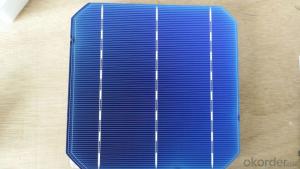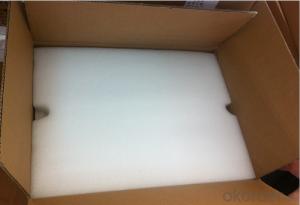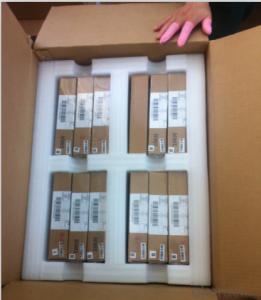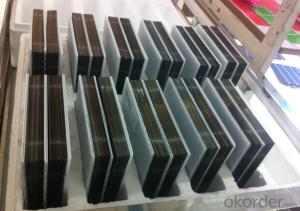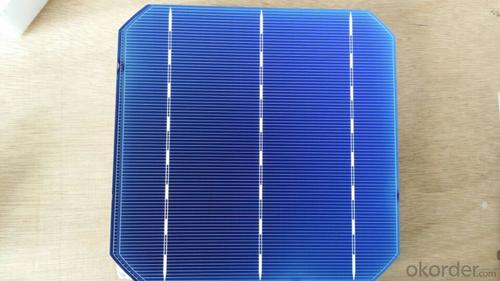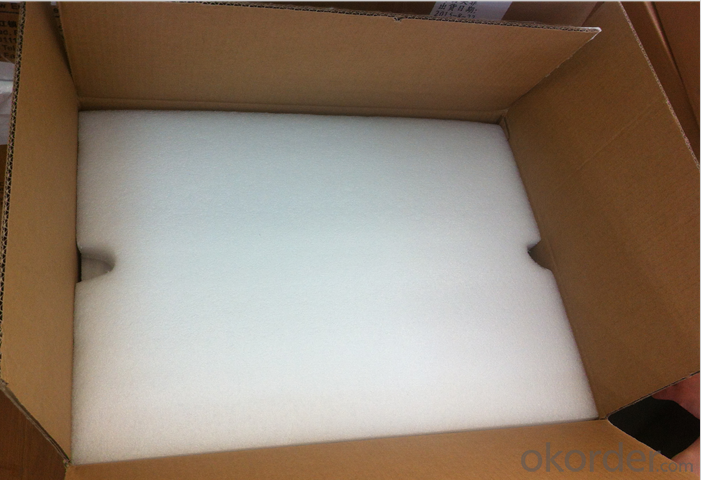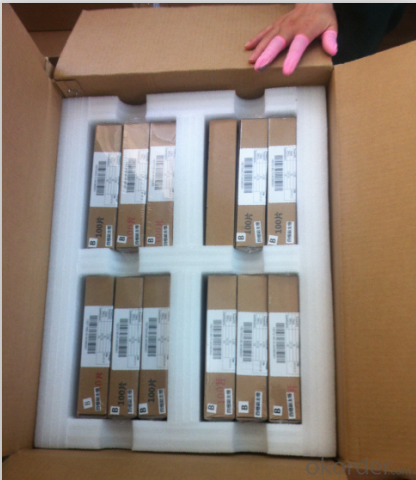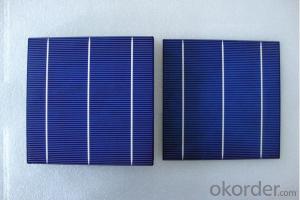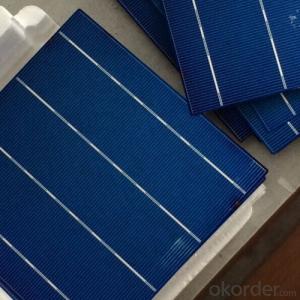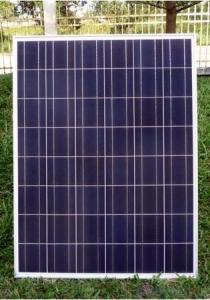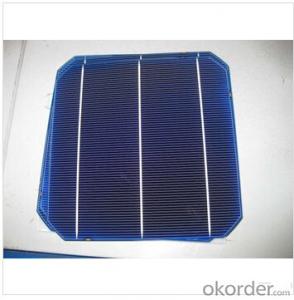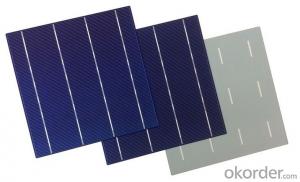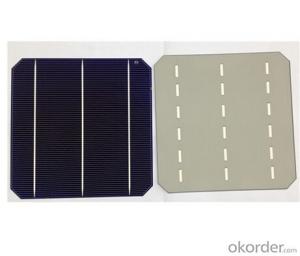Solar Cells for Dummies:156x156mm 3bb Mono Solar Cells 6x6 with Superior Quality
- Loading Port:
- China main port
- Payment Terms:
- TT OR LC
- Min Order Qty:
- 100 watt
- Supply Capability:
- 500000 watt/month
OKorder Service Pledge
OKorder Financial Service
You Might Also Like
Specification
156x156mm 3BB Mono Solar Cells 6x6 with Sperior Quality
Feature
1.High conversion efficiencies resulting in superior power output performance.
2.Outstanding power output even in low light or high temperature conditions
3.Optimized design for ease of soldering and lamination
4.Long-term stability,reliability and performance
5.Low breakage rate
6. Output power tolerance of +/-3%
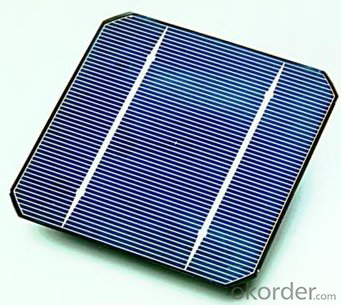
Physical characteristic
Dimension: 156*156mm±0.5mm
Thickness: wafer(Si):200μm±20μm
Cell:240μm±40μm
Front: silver bus bars;dark blue/others silicon nitride anti reflection coating
Back: silver/aluminum bus bars;full-surface aluminum BSF
Warranty
25-years limited warranty on power output: 10 years/90%, 25 years/80%
Packaging
The solar cells are packed in cartons, and then pallet.
Shipping by sea or by air are both ok, it's up to customer’s choice.
We’d like to inquire the freight cost for customer after be informed exact quantity and destination address
- Q: Can solar cells be used in hybrid systems?
- Yes, solar cells can be used in hybrid systems. Hybrid systems combine different sources of energy, such as solar, wind, or fossil fuels, to generate electricity. Solar cells can be integrated into these systems to harness solar energy and contribute to the overall power generation. This allows for a more sustainable and efficient energy production, reducing reliance on traditional energy sources.
- Q: Are bulk solar cells better than the normal solar cells?
- Bulk solar cells are not absolutely better than normal solar cells, it is decided by what kind of material.
- Q: Can solar cells be integrated into building materials?
- Yes, solar cells can be integrated into building materials. Building-integrated photovoltaics (BIPV) is a growing trend where solar cells are embedded into roofing materials, windows, facades, and other building components. This integration allows for the generation of electricity while maintaining the aesthetics and functionality of the building.
- Q: Can solar cells be used in countries with limited sunlight?
- Yes, solar cells can still be used in countries with limited sunlight. While it is true that solar cells generate more electricity in areas with abundant sunlight, they can still function and produce energy in regions with less sunlight. Advances in solar panel technology, such as the use of more efficient materials and improved designs, have made it possible to harness solar power even in countries with limited sunlight. Additionally, the use of energy storage systems, like batteries, can help store excess energy generated during peak sunlight hours for use during low-light periods. Therefore, solar cells can still be a viable and sustainable energy solution in countries with limited sunlight.
- Q: Can solar cells work in cloudy weather?
- Yes, solar cells can still work in cloudy weather, although their efficiency may be reduced. Clouds diffuse sunlight, causing a decrease in the amount of direct sunlight reaching the solar cells. However, solar cells can still generate electricity from the diffused sunlight, although at a lower rate compared to sunny conditions.
- Q: What is the maximum efficiency of a solar cell?
- The maximum efficiency of a solar cell refers to the highest percentage of sunlight that can be converted into usable electricity by the cell. Currently, the highest efficiency achieved by commercial solar cells is around 26-27%. However, in laboratory settings, experimental solar cells have reached efficiencies of up to 46%.
- Q: Can solar cells be used for powering hotels?
- Yes, solar cells can be used for powering hotels. Solar cells, also known as photovoltaic cells, convert sunlight into electricity, providing a sustainable and renewable energy source. By installing solar panels on the roofs or in open spaces around hotels, they can generate clean energy to meet a portion or even the entire electricity demand of the establishment, reducing reliance on traditional power sources and resulting in cost savings.
- Q: Can solar cells be used underwater?
- No, solar cells cannot be used underwater as they rely on sunlight to generate electricity. Water blocks sunlight and prevents the solar cells from functioning effectively.
- Q: How do solar cells impact energy consumption patterns?
- Solar cells have a significant impact on energy consumption patterns by providing a clean and renewable source of electricity. They reduce reliance on fossil fuels, thereby decreasing greenhouse gas emissions and mitigating climate change. Solar cells also empower individuals and communities to generate their own electricity, reducing dependence on centralized power grids and promoting energy independence. Additionally, solar cells can contribute to peak load shaving, as they generate the most electricity during daylight hours when energy demand is typically high. Overall, solar cells play a crucial role in transitioning towards a more sustainable and environmentally friendly energy consumption pattern.
- Q: What is the role of bypass diodes in shading situations?
- The role of bypass diodes in shading situations is to minimize the impact of shading on the overall performance of a solar panel. When a section of a solar panel is shaded, it can significantly reduce the current produced by that section, leading to a decrease in the overall power output. Bypass diodes are connected in parallel to each solar cell or a group of cells within a solar panel to provide an alternative path for the current to flow when shading occurs. This allows the shaded cells to be bypassed, preventing them from affecting the performance of the unshaded cells. By utilizing bypass diodes, the solar panel can maintain a higher level of efficiency and generate more power, even in shading situations.
Send your message to us
Solar Cells for Dummies:156x156mm 3bb Mono Solar Cells 6x6 with Superior Quality
- Loading Port:
- China main port
- Payment Terms:
- TT OR LC
- Min Order Qty:
- 100 watt
- Supply Capability:
- 500000 watt/month
OKorder Service Pledge
OKorder Financial Service
Similar products
Hot products
Hot Searches
Related keywords
